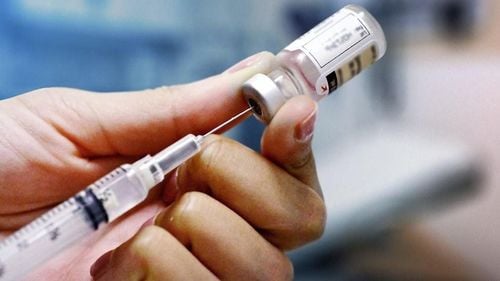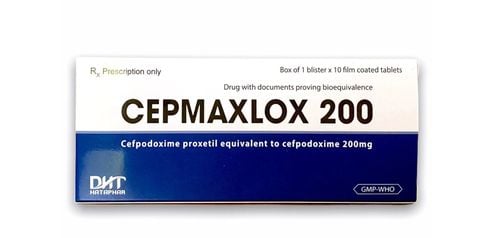This is an automatically translated article.
Perikacin medicine has the main active ingredient is the antibiotic ceftazidime in the form of ceftazidime pentahydrate with a content of 1g and other excipients in a sufficient amount. This is a 3rd generation Cephalosporin antibiotic that is used to treat bacterial infections.1. What is Perikacin?
What is Perikacin? The drug Phartino has the main active ingredient is ceftazidime antibiotic in the form of ceftazidime pentahydrate with the content of 1g and other excipients in sufficient quantity. This is a 3rd generation Cephalosporin antibiotic that is used to treat bacterial infections.
Perikacin is prepared in the form of a powder for injection, suitable for intravenous use.
1.1. Pharmacodynamics of antibiotics Ceftazidime The main active ingredient Ceftazidime is a 3rd generation Cephalosporin antibiotic.
1.2. Pharmacokinetics of antibiotics Ceftazidime Absorption: Active substance Ceftazidime is not able to be absorbed from the gastrointestinal tract. Therefore, drugs containing this ingredient are usually administered intravenously or intramuscularly. Distribution: Only about 10% of the drug is bound to plasma proteins. Active ingredient Ceftazidime has the ability to penetrate deep tissues and peritoneal fluid. The drug reaches therapeutic concentrations in the cerebrospinal fluid during meningitis. This drug crosses the placenta and is excreted in breast milk. Metabolism: Active substance Ceftazidime is not metabolised. Elimination ability: about 80-90% of the dose is excreted in the urine after 24 hours. Excretion in bile is less than 1%. 1.3. The effect of antibiotics Ceftazidime Active ingredient Ceftazidime has a bactericidal effect caused by inhibition of bacterial cell wall synthesis enzymes. The drug is stable to most bacterial beta-lactamases except for Bacteroides enzymes. The drug is sensitive to many aminoglycoside-resistant gram-negative organisms and many gram-positive organisms that are resistant to ampicillin and other cephalosporins. Antibacterial spectrum:
Works well with: aerobic gram-negative bacteria including E.coli, Pseudomonas, Proteus, Shigella, Salmonella, Haemophylus influenza... Some strains of Pneumococcus, Klebsiella, Moraxella catarrhalis and beta-hemolytic Streptococcus and Streptococcus viridans. Many anaerobic gram-positive strains are also susceptible, staphylococcus aureus is moderately sensitive to the antibiotic Ceftazidime. Resistance: Resistance may develop during treatment due to loss of inhibitory effect on chromosome-mediated beta-lactamases (especially for Enterobacter, Pseudomonas spp. and Klebsiella). Ceftazidime is not effective against methicillin-resistant Staphylococcus aureus, Enterococcus, Bacteriodes fragilis, Listeria monocytogenes, Campylobacter spp., Clostridium difficile.
2. What disease is Perikacin used to treat?
Perikacin is used in the treatment of diseases as follows:
Lower respiratory tract infections. Skin and skin structure infections. Urinary tract infections include both complicated and uncomplicated forms. Bone and joint infections. Gynecological infections. Abdominal infection. Central nervous system infections including meningitis.
3. Usage and dosage of Perikacin
3.1. Dosage of Perikacin The usual dose for adults is 1g every 8 hours or 2g every 12 hours, by intravenous or deep intramuscular infusion. No dose adjustment is required in case of impaired liver function.
Dosage for children as prescribed by the doctor or recommended below:
Newborns (from 0-4 weeks) dose 30 mg/kg IV every 12 hours. Children from 1 month to 12 years old: 30-50 mg/kg intravenously up to 6g/day for a period of 8 hours. Dosage in the elderly: the usual dose should not exceed 3g per day, especially in people over 70 years of age.
In case of overdose can lead to neurological sequelae including encephalopathy, convulsions, and coma. Ceftazidime serum concentrations may be reduced by dialysis.
3.2. How to use Perikacin Perikacin is administered by intravenous infusion or deep intramuscular injection: usually injected into the upper quadrant of the buttocks or the lateral part of the thigh. Instructions for mixing solution for infusion. Solution for intramuscular injection: Dissolve Perikacin in 3ml of distilled water for injection, or 0.5% or 1% lidocaine hydrochloride solution. Intravenous solution: Dilute Perikacin in 10ml of distilled water for injection, or 0.9% sodium chloride or 5% dextrose solution. Solution for infusion: Mix Perikacin in solutions as in intravenous injection but with a concentration of 10-20 mg/ml (1-2g drug in 100ml solvent).
4. Undesirable effects of the drug Perikacin
During the use of Perikacin, users may experience some unwanted effects, specifically as follows:
Shock: shock may occur, although rare, so users need to be cautious. If dystonia, taste abnormalities, stridor, dizziness, tinnitus, diaphoresis occur, Perikacin should be discontinued and/or the treatment changed. Hypersensitivity reactions: if rash, urticaria, erythema, pruritus, flushing, erythema nodosum, angioedema, anaphylactic reactions (including bronchospasm and/or hypotension occur) pressure), it is necessary to discontinue the drug and/or change the treatment. Dermatology: Rarely, erythema, Lyell's syndrome or toxic epidermal necrolysis or Stevens-Johnson syndrome may occur. For the central nervous system: causes headaches, dizziness, paresthesias and decreased taste. Some neurological sequelae, including tremor, myoclonus, convulsions, and encephalopathy, have been reported in patients with renal insufficiency receiving Perikacin without adequate dose reduction. Renal: Rare cases of severe renal impairment, including acute renal failure, have been reported, therefore frequent patient monitoring is required. If any of these symptoms occur, the drug should be discontinued and/or the treatment changed. For hematology: rare, causing pancytopenia, decreased white blood cell count, agranulocytosis, hemolytic anemia, lymphocytosis, increased platelet count, anemia, decreased white blood cell count granules and increased eosinophils, decreased neutrophils, decreased platelet counts. Occasionally causes transient increases in blood urea, blood nitrogen and/or serum creatinine. For the liver: rarely, sometimes causing jaundice, increased ALT, AST, AL-P, bilirubin, LDH, GGT, g-GTP. For the digestive system: rarely severe colitis with bloody stools of pseudomembranous colitis. If frequent diarrhea occurs, the drug should be discontinued. Sometimes the use of the drug can cause nausea, vomiting, diarrhea, loss of appetite. For the respiratory system: in the use of antibiotics of the Cephalosporin group can cause cough, difficulty breathing. If these signs and symptoms occur, it is necessary to discontinue the drug and/or change the treatment including the use of adrenocorticotropic hormone. Superinfection: rare, causing stomatitis, candidiasis. Vitamin deficiency: rare, can cause vitamin K deficiency and vitamin B deficiency (signs such as glossitis, stomatitis, anorexia, neuritis). Other possible side effects include phlebitis or thrombophlebitis following intravenous administration, and pain and/or inflammation following intramuscular administration. Patients should proactively notify their treating doctor of any unwanted effects encountered when using Perikacin for examination, treatment, and timely treatment.
5. Perikacin drug interactions
Perikacin drug interactions may alter its ability to work or increase the effects of unwanted effects. You need to proactively list all your prescription and over-the-counter medicines, herbal products, vitamins and minerals, or health foods to your treating doctor or pharmacist. that you are using to minimize possible adverse drug interactions during treatment.6. Some notes when using Perikacin
6.1. Contraindications of the drug Perikacin People with a history of shock while using the drug. People with hypersensitivity to cephalosporin antibiotics. Contraindications of Perikacin should be understood as absolute contraindications. This means that there are no contraindications to the use of Perikacin for any reason.
6.2. Precautions when using Perikacin Caution when using this drug with people with a history of hypersensitivity to the antibiotic Ceftazidime, Cephalosporins and Penicillins. There is a cross-reactivity between penicillins and cephalosporins, so caution should be exercised when these two drugs are used together. Pseudomembranous colitis may occur with the use of the drug. Patients with renal impairment: The total daily dose should be reduced in patients with renal impairment. High concentrations of Perikacin can cause convulsions, encephalopathy, loss of balance, and neuromuscular excitability. Treatment with Ceftazidime may reduce prothrombin activity in people with renal, hepatic or malnourished. Use caution when using the drug for people with a history of gastrointestinal disease, especially dysentery. 6.3. Use in pregnancy and lactation For pregnant women: Medicines containing the active ingredient Cephalosporin are considered safe during pregnancy. However, there are no adequate and well-controlled studies in pregnant women, so this drug should be used during pregnancy only if clearly needed. For breast-feeding women: The active ingredient Ceftazidime contained in the drug Perikacin has the risk of being secreted into breast milk, so it should be considered when using the drug for women who are breast-feeding. Above is all information about Pentanis drug, patients need to carefully read the instructions for use, consult a doctor / pharmacist before using. Absolutely do not arbitrarily buy Pentanis to treat diseases at home, because there may be unwanted side effects on health.
Follow Vinmec International General Hospital website to get more health, nutrition and beauty information to protect the health of yourself and your loved ones in your family.













